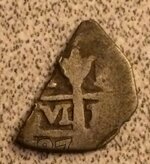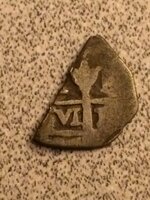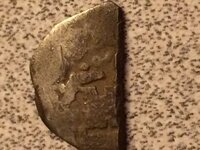Navigation
Install the app
How to install the app on iOS
Follow along with the video below to see how to install our site as a web app on your home screen.
Note: This feature may not be available in some browsers.
More options
You are using an out of date browser. It may not display this or other websites correctly.
You should upgrade or use an alternative browser.
You should upgrade or use an alternative browser.
can anyone give me a date time frame of this cob
- Thread starter VBFD53
- Start date
Geoff Zitver
Jr. Member
- Aug 28, 2016
- 25
- 49
- Detector(s) used
- Whites PI-1000/ Fisher 1280x Aquanaut/ Pulse Induction units/ Fisher CZ21 Quick Silver/Fisher 1266/Fisher 1270
- Primary Interest:
- Shipwrecks
This is a Potosi mint one real (clipped), E assayer, (Elgueta o Ergueta). I can barely see the tops of the date on the obverse of the coin (Pillar and Wave side), but it appears to me as 1665. Usually, only the last two digits of the date are seen on Pillar and Waves type cobs, (Obverse and Reverse) so if you look below the VI on the obverse side (which is actually UL, and part of the legend "Plus Ultra") you can see the extreme tops of two digits (65). 1665 is the correct time frame for "E" Assayer at the Potosi mint. The left half of the "E" Assayer mark can be seen at the one o'clock position which would be to the right of the Pillar on the obverse. The extreme lower right of the 1 (indicating denomination) can be seen at the 12 o'clock position of the obverse and to the left of the Pillar. The castle variant visible on the reverse is also known to this era. Refer to Sellschopp, "Coinage of Peru", page182any ideas will be appreciatedhttp://www.treasurenet.com/forums/attachment.php?attachmentid=1332367&d=1467570048&thumb=1&stc=1View attachment 1332367View attachment 1332368
front and back of coarse
Trez
Hero Member
- May 10, 2006
- 768
- 269
- Detector(s) used
- Sov Elite, CZ20, Minelab Sovereign XS, Explorer II, My eyeballs to bloody fingers have done me well also.
- Primary Interest:
- All Treasure Hunting

VBFD53,
Geoff offering up some good details...and good eye, very well could be assayer E...the 6 isn't adding up.
May be a few years off, looking more like 1697...assayer F is my wild azz guess...
could very well be assayer E, but the date just isn't adding up, looks like 85 or 87 but that eliminates assayer E.
But I'm feeling F as assayer...nice piece.
Trez
Last edited:
Geoff Zitver
Jr. Member
- Aug 28, 2016
- 25
- 49
- Detector(s) used
- Whites PI-1000/ Fisher 1280x Aquanaut/ Pulse Induction units/ Fisher CZ21 Quick Silver/Fisher 1266/Fisher 1270
- Primary Interest:
- Shipwrecks
Trez, your guess is well taken, although, "F" assayer struck only eight reales in 1697 (Sellschopp, page 192.) Assayers were paid according to the weight of their production, so striking eight reales was infinitely more profitable. Other than that, their is no know explanation why "F" assayer did not strike one reals in 1697, but this being historically known absolutely rules out assayer "F". The number 5 was carved onto coin dies differently in the 1600s compared to what we are used to seeing today. With the extreme angle on the top portion of the second digit, I'll have to stick with my opinion that this cob is an "E" assayer, 1665. I'll have to say though, that there isn't much for us to look at on this cob, and there is room for some speculation, but it is unquestionable that this piece is certainly a late 1600s period Carlos II Potosi mint cob one real, making both of us correct in our assumptions. When I left Treasure Salvor's Inc in Key West FLA, I worked for Conch Coin Company (a couple blocks away from the Mel Fisher museum.) With the hundreds of Cob coins I personally certified, I think "E" was the most common assayer I found on the Pillar and Wave Potosi cobs. "F" was less common to find as he worked as assayer for only four years (1697-1701). "E" assayer struck for 13 years (1666-1679) and is another reason why I believe "E" struck this Cob. Again, both of us are correct with the coins origin and time frame which answers VBFD53 with ample detail. The untrained eye would never see what we're looking at, and I appreciate your interest and opinion of my observations.VBFD53,
Geoff offering up some good details...and good eye, very well could be assayer E...the 6 isn't adding up.
May be a few years off, looking more like 1697...assayer F is my wild azz guess...
could very well be assayer E, but the date just isn't adding up, looks like 85 or 87 but that eliminates assayer E.
But I'm feeling F as assayer...nice piece.
Trez
Trez
Hero Member
- May 10, 2006
- 768
- 269
- Detector(s) used
- Sov Elite, CZ20, Minelab Sovereign XS, Explorer II, My eyeballs to bloody fingers have done me well also.
- Primary Interest:
- All Treasure Hunting
Trez, your guess is well taken, although, "F" assayer struck only eight reales in 1697 (Sellschopp, page 192.) Assayers were paid according to the weight of their production, so striking eight reales was infinitely more profitable. Other than that, their is no know explanation why "F" assayer did not strike one reals in 1697, but this being historically known absolutely rules out assayer "F". The number 5 was carved onto coin dies differently in the 1600s compared to what we are used to seeing today. With the extreme angle on the top portion of the second digit, I'll have to stick with my opinion that this cob is an "E" assayer, 1665. I'll have to say though, that there isn't much for us to look at on this cob, and there is room for some speculation, but it is unquestionable that this piece is certainly a late 1600s period Carlos II Potosi mint cob one real, making both of us correct in our assumptions. When I left Treasure Salvor's Inc in Key West FLA, I worked for Conch Coin Company (a couple blocks away from the Mel Fisher museum.) With the hundreds of Cob coins I personally certified, I think "E" was the most common assayer I found on the Pillar and Wave Potosi cobs. "F" was less common to find as he worked as assayer for only four years (1697-1701). "E" assayer struck for 13 years (1666-1679) and is another reason why I believe "E" struck this Cob. Again, both of us are correct with the coins origin and time frame which answers VBFD53 with ample detail. The untrained eye would never see what we're looking at, and I appreciate your interest and opinion of my observations.
Geoff,
point taken and agreed we are close to narrowing the year(s), but correct me if I'm wrong but history has been re-written...apparently assayer F did indeed produce 1 reales Type II-Standard issue (Po 320) 1697. Sewall Menzel Cobs, Pieces of Eight and Treasure Coins page 335 shows a beautiful example...that is why I questioned the date.
His coinage is listed as quite rare...thus is why I responded to this post VBFD53 may have actually indeed found one from this rare assayer, just a possibility. But I can see it...
I love this hobby, maybe Mac can chime in, wonder why he hasn't. Mac?
Trez
Geoff Zitver
Jr. Member
- Aug 28, 2016
- 25
- 49
- Detector(s) used
- Whites PI-1000/ Fisher 1280x Aquanaut/ Pulse Induction units/ Fisher CZ21 Quick Silver/Fisher 1266/Fisher 1270
- Primary Interest:
- Shipwrecks
Trez, Again, there's nothing visible on this coin which would allow us to be absolutely certain in trying to identify the assayer. We could probably go back and forth on it for eternity. Yes, the historical data regarding the new world Spanish mints are constantly changing, but nothing drastic. Most of what we know is good. I grabbed my Sellschopp off the book shelf for reference, but didn't look at any of my other books concerning this coin. Thanks for pointing out the change, I'll have to take as look.Geoff,
point taken and agreed we are close to narrowing the year(s), but correct me if I'm wrong but history has been re-written...apparently assayer F did indeed produce 1 reales Type II-Standard issue (Po 320) 1697. Sewall Menzel Cobs, Pieces of Eight and Treasure Coins page 335 shows a beautiful example...that is why I questioned the date.
His coinage is listed as quite rare...thus is why I responded to this post VBFD53 may have actually indeed found one from this rare assayer, just a possibility. But I can see it...
I love this hobby, maybe Mac can chime in, wonder why he hasn't. Mac?
Trez
realeswatcher
Full Member
- Sep 1, 2010
- 120
- 24
Top Member Reactions
-
 3507
3507 -
 1992
1992 -
 1895
1895 -
 1164
1164 -
 1069
1069 -
 1012
1012 -
 877
877 -
 873
873 -
 849
849 -
 785
785 -
 763
763 -
 665
665 -
 660
660 -
 571
571 -
 508
508 -
 450
450 -
 439
439 -
 404
404 -
E
401
-
 397
397
Users who are viewing this thread
Total: 2 (members: 0, guests: 2)







